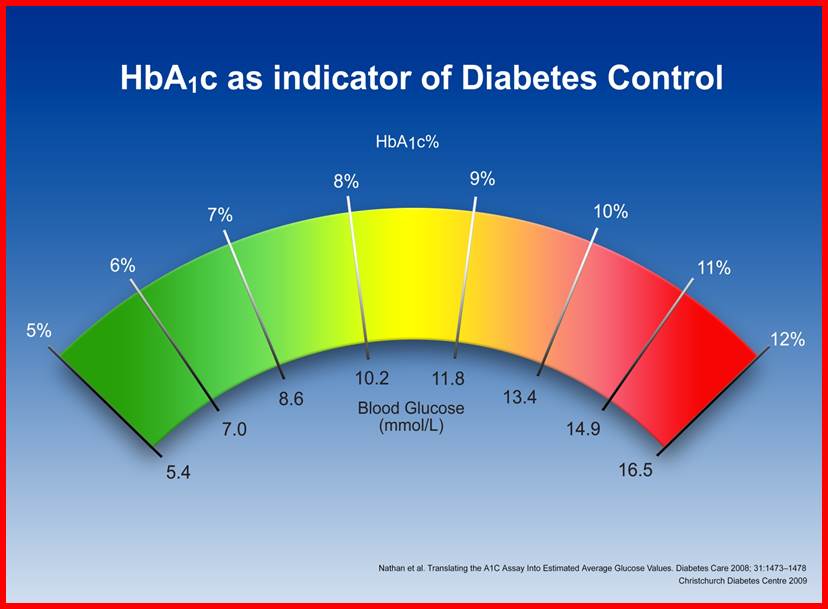15. Long term goals for diabetes management
HbA1c
The HbA1c (sometimes called Glycosolated Haemoglobin) is the percentage (%) of haemoglobin (a molecule found in our red blood cells) which has glucose attached.
Lots of different substances in our blood stick to haemoglobin, either to get to tissue cells or because there is an excess amount in the blood.
When blood glucose levels remain persistently high, the excess glucose attaches to the haemoglobin. In other words when the daily blood sugar levels remain high for prolonged periods of time, the HbA1c reading also increases.
Red blood cells live for around 120 days so the HbA1c test undertaken at clinic visits gives us a reading of all the excess glucose which is stuck to the haemoglobin over the 3 month period before this.
In clinic we use a machine called a DCA 2000 analyser to measure HbA1c. This is done using your own finger pricker in clinic. The result takes about 5 minutes.
HBa1c targets
The recommended HbA1C for children is under 58mmols/mol
| HbA1c | |
| < 45mmols/mol | A person without diabetes would have a HbA1c under 45mmols/mol. Children with type 2 diabetes may also have a HbA1c closer to this range. This level is too low for a person with type 1 diabetes as it may put them at risk of frequent episodes of hypoglycemia. |
| 58mmols/mol | This is the recommended target for HbA1c for children with type 1 diabetes. |
| >58 mmol/mol | HbA1c levels for children that are greater than the target suggests that the blood glucose levels are persistently above target. The diabetes team and family will need work together to implement strategies to help get blood glucose levels back in target range. Prolonged raised HbA1c can increase the risk of complications. |

Overall targets for diabetes management
The overall goal for people with diabetes is to try to keep daily blood glucose levels and HbA1c within the recommended target range without frequent hypoglycemia (lows).
A child having lots of fluctuations in daily blood glucose levels (i.e. frequent episodes of hypoglycemia but very high blood glucose levels the rest of the time) could possibly still have a HbA1c reading in the recommended range. This kind of pattern in the blood glucose profile would not be considered ideal and changes to the treatment plan will be required to address this.
Hba1c is only one tool used to assess the overall diabetes control. The day to day blood glucose tests provide very important information on overall diabetes control. It is therefore very important to continue to test, document and review blood glucose levels as recommended by your diabetes team. The diabetes team will want to see these levels to assist with adjustment of the treatment plan so for this reason it is very important to bring your child's meter and log book / downloaded CGMS or pump information to every clinic.
Clinic
Aside from looking at the diabetes log book and doing the HbA1c test at clinic every 3 months, the diabetes team also look at other things to help guide treatment plans for healthy outcomes. Both weight and height and changes of puberty are also good indicators health and wellness in children.
Clinic visits are where families work together with the diabetes team to negotiate individualised plans of care.
Screening for complications of diabetes
What are complications of diabetes?
When blood glucose levels remain higher than normal, excess glucose can stick to blood vessels and nerves in our bodies. Over extended periods of time, this can affect how these parts of the body function.
The importance of follow up and screening
Risk of diabetes complications increases with the following risk factors:
longer duration of diabetes
blood glucose levels that are consistently outside of the target range
high blood pressure
smoking
history in the family of diabetes with complications.
Complications are rare in children and young people. Maintaining glucose levels as close as possible within the target range from early on is important and helps establish good long-term habits.
You will be given laboratory forms in clinic when complications screening is due. This is generally after:
2 years if your child was aged above 10 at time of diagnosis and
After 5 years if aged less than 10 years.
Once screening is commenced it is generally undertaken each year. Screening blood and urine tests are the only way that early signs of complications can be detected.
Health of the eyes
The tiny blood vessels which supply blood to our retina (or the bit of the eye that allows us to see) can be affected by persistent high blood glucose levels. The vessels can become weak as the excess glucose sticks to them until the blood supply to the eye is greatly reduced. This is called retinopathy. If this condition progresses to a stage where vision is impaired, specialised laser treatment can be used to treat the condition. Retinal screening is generally undertaken 1-2 yearly once annual screening has commenced. Retinal screening can only be undertaken by specialist centres.

Kidney health
Our kidneys are our body's filtering units. The small blood vessels that supply our kidneys can also be affected by persistent high blood glucose levels causing gradual damage to the kidneys called nephropathy. Early changes in kidney function can be detected on a simple urine test that detects microscopic amounts of protein leaking from the kidney. Checking the urine for protein (albuminuria) is done every year once annual screening has commenced. Blood pressure is also checked at every clinic visit as part of checking kidney health. There are medications (tablets) that can be used to protect the kidneys if there is persistent leakage of protein.
Nerve health
Persistently high levels of glucose in the blood over prolonged periods (decades) can get trapped in the tiny areas of the nerves which relay important information to our brains. This is called neuropathy. It is possible to reverse the effects of nerve damage with improved blood glucose levels. Highly sensitive tests focussing on reflexes and sensation are used to assess nerve health. These tests are generally not done until over the age of 16 years.
Cardiovascular/heart health
As part of regular annual diabetes screening for cardiovascular health, the amount of cholesterol in the blood is checked. This is called a lipid screen.
Medical conditions that can occur with diabetes
Thyroid problems
There is slight increased risk of other autoimmune conditions that can occur with type 1 diabetes. An underactive thyroid gland (hypothyroidism) occurs in 3 to 8 per cent of children with diabetes. Symptoms and signs may include tiredness, weight gain, poor growth, problems with diabetes control and an enlarged thyroid gland (goitre). Diagnosis is with a blood test for thyroid function. If hypothyroidism is detected it is treated by giving thyroid replacement tablets.
Hyper-activity of the thyroid gland (hyperthyroidism) is also a slightly increased risk with diabetes. Symptoms and signs may include weight loss, nervousness, increased appetite, tremor, feeling excessively hot, problems with diabetes control and an enlarged thyroid gland (goitre). This also can usually be treated with medications in tablet form.
Problems with the thyroid are antibody-related (auto-immune) conditions. All children within the Starship Diabetes Service have their thyroid function checked at the time of diagnosis, then screening for thyroid function is undertaken every year once annual screening is commenced.
Coeliac disease
Coeliac disease occurs in about 5 per cent of children with diabetes and is another auto-immune condition in which the body forms antibodies against the protein gluten which is found in grains. These antibodies cause damage to the bowel lining which may cause poor absorption of food, anaemia, poor growth, and unstable diabetes. In many children, no symptoms may be evident except unstable diabetes control. All children diagnosed with diabetes mellitus at Starship are screened for coeliac disease at the time of diagnosis. Screening for coeliac disease is via a blood test every year once annual screening is commenced.
Coeliac disease can be treated by diet changes which involve avoiding the grains containing gluten. This treatment is very effective but adds an extra complexity to diabetes care. Advice from an experienced dietitian is essential.
Further resources
Ministry of Health HbA1c levels wallet card
Let's go over the main points. Think you've got it sorted? Read through our one page summary.
Think you've got it sorted now?
If you have read through the information above, and you feel confident that you understand this topic, print off and fill in the evaluation form below (you might need to ask someone to print this off for you) and return to the nurse on your ward. If you have any questions, note them down on this form and your diabetes nurse specialist will discuss them with you.
Long Term Goals for diabetes management: Evaluation
After reading this module, I feel confident in:
| Yes | No | |
| Understanding what the HbA1c test is and interpreting the result | ||
| Understanding why my child needs to be seen regularly within the diabetes clinic | ||
| Understanding why it is important to screen regularly for complications of diabetes | ||
| Understanding how I can reduce the risk of complications of diabetes |
Comments:
Date:
Name:
